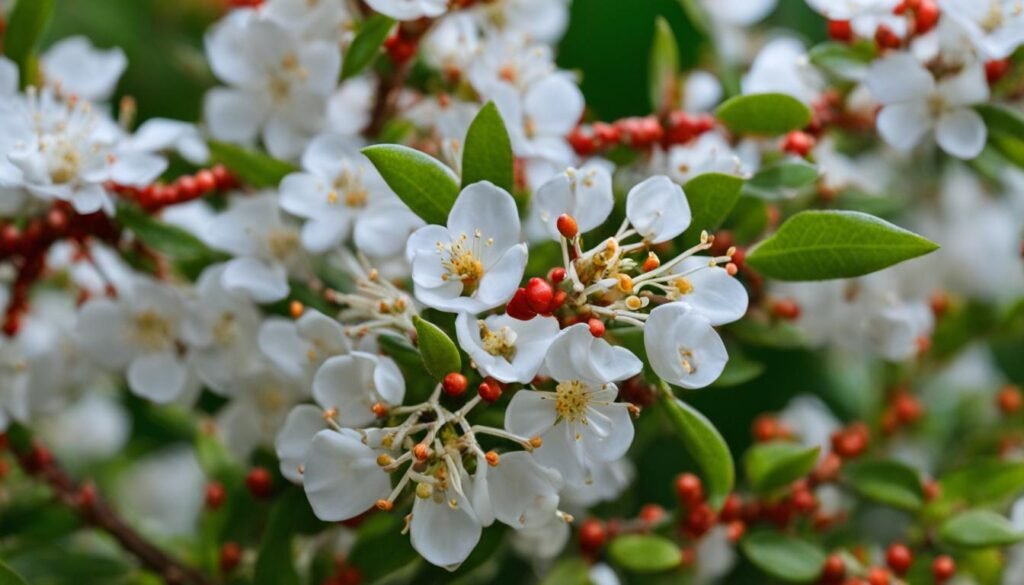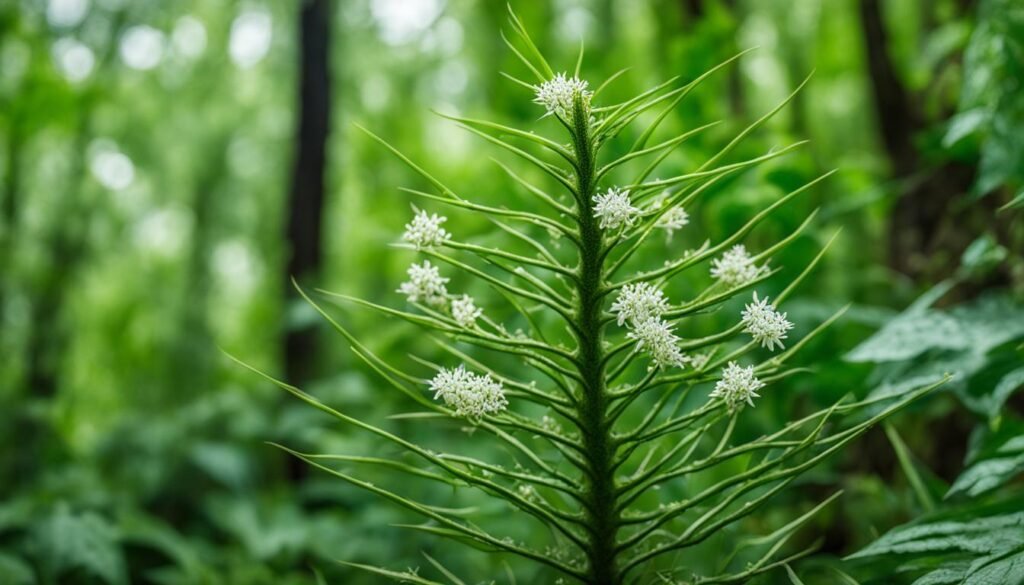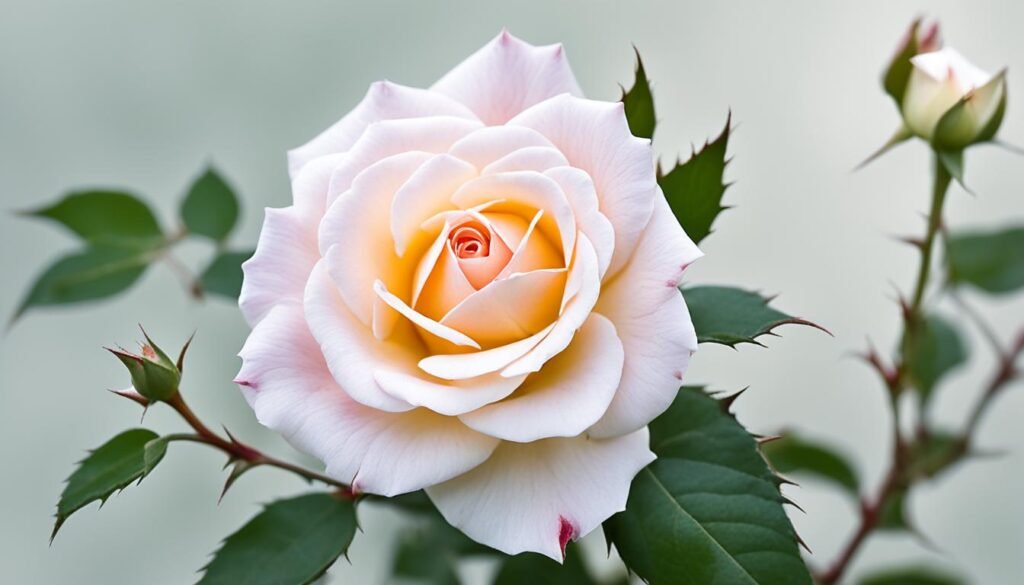When it comes to creating a beautiful and secure garden, there’s nothing quite like plants with white flowers and thorns. Not only do these plants add an elegant touch with their striking white blossoms, but they also act as a natural deterrent to potential intruders. Imagine a garden filled with stunning white blooms, surrounded by the protective embrace of thorny stems. It’s a captivating combination that brings both beauty and security to your outdoor space.
Key Takeaways:
- Plants with white flowers and thorns can enhance the aesthetic appeal and security of your garden.
- Popular options include Elaeagnus pungens, Firethorn, Crown of Thorns, Blackberry, Bougainvillea, Eastern Prickly Pear, Devil’s Walking Stick, and Roses.
- Carefully consider your climate and planting zones when selecting security plants.
- Strategically place thorny plants near windows, entry points, and perimeter boundaries for maximum security.
- Creating multiple layers of security with different plant types and sizes can further bolster your garden’s defense.
Elaeagnus pungens
Elaeagnus pungens is a tough evergreen shrub that boasts beautiful white blossoms with a delightful gardenia-like fragrance in the fall. This plant is a perfect choice for those seeking a visually appealing addition to their garden landscape. Elaeagnus pungens is known for its aggressive growth, making it an excellent option for hedges, screening, and bank plantings. Whether you have a sunny or shady garden, this plant can thrive in both conditions.
Aside from its aesthetic appeal, Elaeagnus pungens offers additional benefits. It is resistant to pests, pollution, and salt spray, making it a low-maintenance and hardy plant. However, it’s important to note that this shrub is susceptible to cankers, nematodes, rust, and fungal leaf spots, so proper care and preventive measures should be taken to ensure its health.
When allowed to reach its full potential, Elaeagnus pungens can grow to a height and width of 10 to 15 feet, providing ample coverage and privacy for your garden. This plant is suitable for zones 7, 8, and 9, making it versatile for a wide range of climates and regions.
If you’re looking for a plant with white flowers and thorny stems to enhance your garden, Elaeagnus pungens is a fantastic choice. Its striking blossoms and resilient nature make it a valuable addition to any garden landscape.
Care Requirements for Elaeagnus pungens
| Watering | Light Requirements | Soil Type | Fertilizer |
|---|---|---|---|
| Regular watering; allow the soil to dry between waterings | Partial shade to full sun | Well-draining soil | Fertilize in early spring and mid-summer |
Firethorn
I am excited to introduce you to the versatile Firethorn plant. With its stunning white flowers and thorny stems, Firethorn adds both beauty and security to any garden. In early summer, this plant graces its surroundings with beautiful white blooms, creating a visual spectacle. As the season transitions to fall, Firethorn produces vibrant red and orange berries that add a pop of color to your garden.
Firethorn is not just a pretty face; it can also serve as a natural barrier and fencing in your yard. This plant can grow up to 20 feet tall, providing privacy and deterring intruders with its thorny stems. Its rapid growth rate means you can enhance your home’s security quickly.
Firethorn is well-suited for zones 6 to 9, making it an ideal choice for various regions. However, regular pruning is required to maintain its desired shape and promote optimal growth. By incorporating Firethorn into your garden, you can enjoy its mesmerizing beauty and enhance the security of your outdoor space.

Benefits of Firethorn:
- Striking white flowers add beauty and elegance to any garden
- Thorny stems serve as a natural deterrent to potential intruders
- Produces vibrant red and orange berries, adding color and texture
- Can reach heights of up to 20 feet, creating natural barriers and fencing
- Rapid growth rate allows for quick enhancement of security
- Well-suited for zones 6 to 9
Tips for Growing Firethorn:
- Choose a sunny location for optimal growth
- Ensure well-draining soil to prevent waterlogging
- Water regularly to maintain soil moisture
- Prune regularly to maintain desired shape
- Consider using trellises or stakes for support
Crown of Thorns
Crown of Thorns, scientifically known as Euphorbia, is a thorny plant that produces enduring blossoms in red, white, or pink throughout the year. It can reach heights of up to 3 feet and is suitable for zones 9 to 11. This resilient plant can be planted in flower beds beneath windows to deter unwelcome visitors with its sharp spikes. However, it’s important to handle this plant with caution as it is toxic and can cause skin irritation.
Key Highlights of Crown of Thorns:
- Scientific Name: Euphorbia
- Height: Up to 3 feet
- Blossom Colors: Red, white, or pink
- Suitable Zones: 9 to 11
- Features: Thorny plant with enduring flowers
- Uses: Flower beds beneath windows for security
- Precautions: Toxic plant that can cause skin irritation
With its striking blossoms and sharp thorns, the Crown of Thorns is an attractive yet effective addition to your garden landscape. Its enduring flowers and toxic nature act as a deterrent to potential intruders, making it a valuable security plant.
“The Crown of Thorns is not only visually appealing but also serves as a natural defense system for your garden. Its prickly nature and toxic properties make it an ideal choice for enhancing security without compromising on beauty.” – Garden Expert
When planting the Crown of Thorns, it’s important to choose a suitable location, such as flower beds beneath windows, to maximize its security benefits. Remember to exercise caution when handling the plant due to its toxicity.
Blackberry
Blackberries are thorny plants that provide both security and a delicious summer treat for your home. These plants create a natural deterrent with their prickly thorns, forming a protective barrier around your property. Not only do blackberries add visual intimidation, but they also offer the added benefit of juicy fruits. Varieties like the Kiowa blackberry, suited for zones 5 to 9, are particularly effective at discouraging unwanted visitors.
One way to enhance your home’s security is by planting blackberries as a dense hedge along property boundaries. This not only improves your privacy but also provides an additional layer of protection. Blackberries are known for their vigorous growth and can quickly form a thick hedge, making it difficult for intruders to trespass.
By incorporating blackberries into your landscape, you can create an aesthetically pleasing garden while boosting your home’s security. The combination of thorny plants with white flowers ensures that your garden not only looks beautiful but also serves as a deterrent to potential threats.

Bougainvillea
Bougainvillea is a plant commonly seen draping over walls in warmer climates. It offers vibrant bracts and, hidden beneath its leaves, formidable thorns. Thorny species like Bougainvillea glabra can provide an extra layer of protection for your walls and property. Consider training bougainvillea to climb trellises, walls, or fences near windows and entry points to enhance security. It thrives in zones 9 and above and can be a stunning addition to your garden landscape.

Benefits of Bougainvillea:
- Provides vibrant bracts that add visual appeal to your garden
- Features thorns that act as a natural deterrent to potential intruders
- Can be trained to climb trellises, walls, or fences near windows and entry points for enhanced security
- Thrives in warmer climates, making it ideal for gardens in zones 9 and above
“Bougainvillea is not only beautiful but also offers an added layer of security to your property. Its vibrant bracts and thorns make it a visually appealing and intimidating plant. By strategically placing bougainvillea near windows and entry points, you can fortify your home while adding a touch of elegance to your garden.” -Gardening Expert
| Variety | Height | Climatic Zone |
|---|---|---|
| Bougainvillea glabra | Up to 30 feet | Zones 9 and above |
| Bougainvillea spectabilis | Up to 40 feet | Zones 8 and above |
| Bougainvillea brasiliensis | Up to 30 feet | Zones 9 and above |
With its stunning blooms and formidable thorns, bougainvillea is a versatile plant that combines beauty and security. Choose the right variety based on your climate and gardening needs, and strategically place it to enhance both the aesthetic appeal and protection of your property.
Eastern Prickly Pear
The eastern prickly pear is a cactus known for its adaptability and sharp spines. It stands at a modest height of around one foot and produces striking yellow blooms in the summer. This plant can be a great addition to dry flower beds, particularly when placed beneath windows. Its spines act as a deterrent to potential intruders while adding a distinctive element to your landscape. Eastern prickly pear is suitable for zones 4 to 9.

If you’re looking for a unique plant that combines beauty and security, the eastern prickly pear is a great choice. With its vibrant yellow flowers and sharp spines, it offers both visual appeal and protection for your garden. Placing it beneath windows not only adds an interesting touch to your landscape but also serves as a natural barrier against intruders.
The eastern prickly pear is a resilient plant that can thrive in dry conditions, making it a low-maintenance choice for your garden. Its adaptability to zones 4 to 9 ensures that it can be grown in a wide range of climates across the United States. Whether you’re looking for a stunning addition to your flower beds or a unique way to enhance security, the eastern prickly pear is a versatile option.
While its sharp spines may deter unwanted visitors, it’s important to handle the eastern prickly pear with care. The spines can cause irritation and should be avoided when handling the plant. By incorporating the eastern prickly pear into your garden, you can enjoy the beauty of its yellow blooms while adding an extra layer of security to your outdoor space.
Devil’s Walking Stick
Devil’s walking stick is an impressive and striking plant that adds both height and security to any garden. This tall, thorny plant is well-known for its formidable spines, which are found on its stems, leaves, and branches.
Thriving in zones 4 to 9, Devil’s walking stick can reach impressive heights of up to 15 feet when grown as a bush and up to 35 feet when allowed to grow as a tree. Its robust nature makes it a suitable choice for creating a dense hedge or barrier along property boundaries.
Although Devil’s walking stick is an excellent choice for enhancing security, it’s important to exercise caution when cultivating it. This plant has invasive tendencies and produces toxic unripe fruits. Proper care and maintenance are essential to prevent it from overpowering other plants in your garden.

With its striking height and defensive spines, Devil’s walking stick offers a visually impactful and protective addition to any garden.
Rose
Roses have long been admired for their beautiful flower petals and thorny branches. These timeless flowers come in various colors, including white, and their mesmerizing fragrance adds a touch of elegance to any garden. While handling roses requires caution due to their thorns, they are a popular choice for both their aesthetic appeal and their potential for enhancing home security.
By planting roses strategically near windows, entryways, or as part of a mixed security hedge, you can create a beautiful barrier that not only adds visual interest but also provides an additional layer of protection for your home. The combination of thorny stems and stunning white blooms acts as a deterrent to would-be intruders, making roses an excellent choice for enhancing your home’s security.

Benefits of Roses for Home Security
Roses offer several advantages when it comes to home security:
- Visual Deterrence: The abundance of thorns on rose bushes creates a natural barrier that discourages unwanted visitors from entering your property. The sight of thorny flowering plants can give potential intruders second thoughts and make them think twice before attempting to breach your home’s security.
- Prickly Protection: The sharp thorns on rose stems can act as a physical deterrent, providing an added layer of security to windows, entryways, and other vulnerable areas. These thorns can make it difficult for intruders to gain access to your home, further enhancing your overall security measures.
- Aesthetic Appeal: Roses are renowned for their beauty and are often associated with romance and elegance. By incorporating roses into your landscape, you not only enhance your home’s security but also create a visually stunning environment that adds value and curb appeal to your property.
Popular Rose Varieties for Home Security
| Rose Variety | Color | Climate |
|---|---|---|
| Iceberg | White | Zones 5-11 |
| Polar Ice | White | Zones 4-9 |
| Thérèse Bugnet | Pale Pink | Zones 3-7 |
| Snow Pavement | White | Zones 3-7 |
| Zéphirine Drouhin | Bright Pink | Zones 6-9 |
These rose varieties thrive in different climates and planting zones, allowing you to choose the most suitable options for your specific location. Whether you prefer the classic elegance of pure white roses or the delicate charm of pale pink blooms, there is a rose variety that can complement your home’s aesthetic while providing an added measure of security.
With their thorny branches and captivating white flowers, roses offer both beauty and protection. By incorporating roses into your landscaping, you can create an enchanting garden that not only enhances your home’s visual appeal but also serves as an effective deterrent to potential intruders.
Choosing the Right Security Plants
When it comes to securing your garden, choosing the right plants is essential. Consider your local climate, suitable planting zones, and the best placement for effective security. Different plants thrive in different conditions, so it’s important to select the right species for your needs. Here are some excellent options to consider:
Firethorn
Firethorn (Pyracantha spp.) is a popular choice for its striking white flowers and thorny branches. This versatile plant not only adds beauty to your garden but also acts as a natural deterrent with its dense, prickly growth. It can be planted near windows, fences, or property boundaries to enhance security. Firethorn is suitable for zones 6 to 9 and requires regular pruning to maintain its shape and neatness.
Blackberry
The blackberry bush (Rubus spp.) is known for its delicious fruits and thorny stems. Planting blackberries along property boundaries can create an effective security barrier. The dense foliage and prickly thorns make it difficult for intruders to access your property. Choose blackberry varieties suitable for your planting zone (usually zones 5 to 9) and enjoy the added benefits of tasty summer harvests.
Crown of Thorns
The Crown of Thorns (Euphorbia milii) is a unique plant that produces stunning white flowers with thorny stems. This low-maintenance plant can be placed near windows, entryways, or in flower beds to deter unauthorized access. It’s important to handle this plant with care as it is toxic and can cause skin irritation. Crown of Thorns thrives in zones 9 to 11, making it an excellent choice for warmer climates.
Bougainvillea
Bougainvillea is a popular plant for adding vibrant color to your garden. It also offers thorny branches that can act as an extra layer of security. Train bougainvillea to climb trellises, walls, or fences near windows and entry points to enhance security. With its tolerance for warm climates (typically zones 9 and above), bougainvillea can be an eye-catching addition to your garden while providing an added level of protection.
Eastern Prickly Pear
The Eastern Prickly Pear (Opuntia humifusa) is a cactus known for its large, sharp thorns and beautiful white flowers. Planting it beneath windows or in dry flower beds can effectively deter intruders. The distinctive appearance of this plant adds an interesting element to your landscape while providing an added layer of security. The Eastern Prickly Pear is suited for zones 4 to 9.
Devil’s Walking Stick
Devil’s Walking Stick (Aralia spinosa) is a tall, thorny plant that can be used as a natural barrier along property boundaries. Its formidable spines on stems, leaves, and branches make it an effective security plant. However, it’s important to note that this plant can be invasive and produce toxic fruits. Devil’s Walking Stick thrives in zones 4 to 9 and can reach impressive heights, adding both security and visual interest to your garden.
Roses
Roses are well-known for their beauty and fragrance, but many varieties also offer thorny branches that act as a deterrent to unwanted visitors. By planting roses near windows, entryways, or as part of a mixed security hedge, you can enhance both the security and aesthetic appeal of your home. Choose roses suited for your climate and planting zone, as different varieties thrive in different regions (typically zones 4 to 9).
By carefully selecting and strategically placing security plants in your garden, you can create a visually appealing landscape while enhancing the safety and security of your home.

| Plant | Climate Zones | Benefits |
|---|---|---|
| Firethorn | 6-9 | Visually striking, dense growth, natural deterrent |
| Blackberry | 5-9 | Prickly thorns create an effective barrier |
| Crown of Thorns | 9-11 | Unique thorny stems, low-maintenance |
| Bougainvillea | 9+ | Vibrant colors, thorny branches |
| Eastern Prickly Pear | 4-9 | Distinctive cactus, large thorns |
| Devil’s Walking Stick | 4-9 | Formidable spines, effective barrier |
| Roses | 4-9 | Beauty, fragrance, and thorny branches |
Placement Strategies for Security Plants
Thoughtful placement of security plants is essential to maximize the effectiveness of your home security. By strategically positioning plants with white blossoms and prickles, you can create a formidable deterrent for potential intruders while enhancing the aesthetic appeal of your garden.
Placing Thorny Climbing Plants along Fences and Walls
One effective strategy is to utilize thorny climbing plants to make it more challenging for intruders to scale your fences or walls. These plants act as natural barriers, adding an extra layer of protection to your property.

Planting Thorny Shrubs or Bushes near Windows and Entry Points
Another effective placement strategy is to plant thorny shrubs or bushes near ground-floor windows and entry points. The presence of prickly plants serves as a visual and physical deterrent, discouraging unauthorized access and deterring potential intruders.
Tip: Be sure to choose plants with thorns that are both visually striking and capable of providing adequate security.
Creating Multiple Layers of Security with a Variety of Plant Types
Enhance the effectiveness of your security measures by creating multiple layers of security using a variety of plant types and sizes. Combining different species with white blossoms and prickles not only enhances security but also adds visual interest to your garden.
Did You Know? Mixing flowering climbers, like bougainvillea or roses, with shrubs like firethorn or Eastern prickly pear can create a visually appealing and highly secure garden.
By implementing these placement strategies, you can optimize the security provided by your plants while creating an appealing and welcoming garden environment.
Conclusion
Incorporating plants with white flowers and thorns into your garden can provide both aesthetic beauty and added security. Whether you choose Elaeagnus pungens, firethorn, crown of thorns, blackberry, bougainvillea, Eastern prickly pear, devil’s walking stick, or roses, each plant offers unique characteristics that can suit various climates and planting zones.
By carefully selecting these plants, you can create a visually appealing garden while enhancing the security of your home. Consider the specific care requirements and growth habits of each plant to ensure they thrive in your garden. Strategic placement near windows and entry points, as well as along fences and walls, can further optimize their security-enhancing benefits.
Remember, plants with white flowers and thorns not only add beauty to your landscape but also act as a natural deterrent to potential intruders. Explore the different varieties mentioned in this plant guide and create a garden that not only captivates with its white blooms, but also provides an extra layer of protection for your property.
